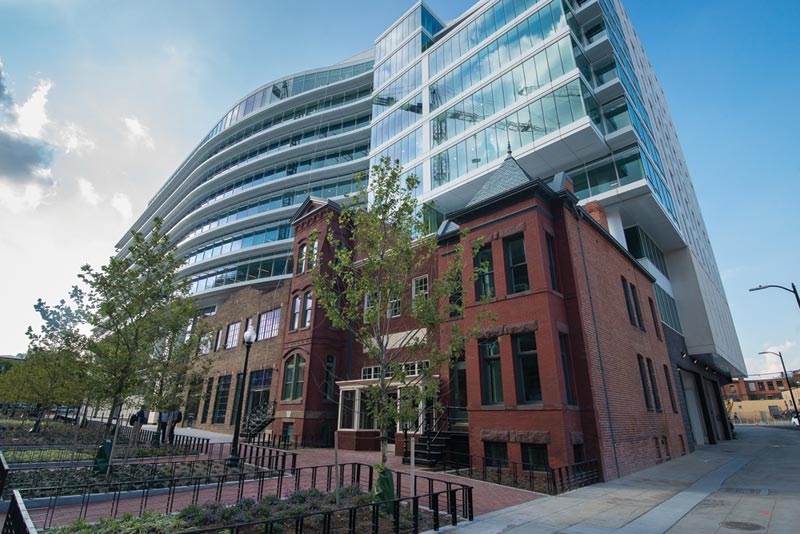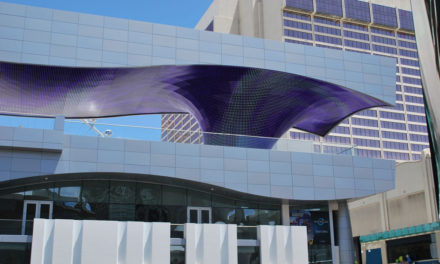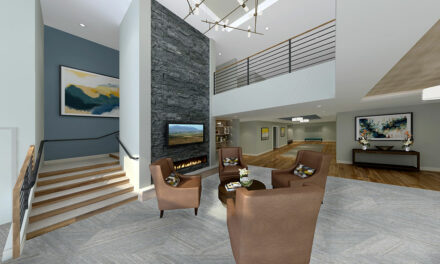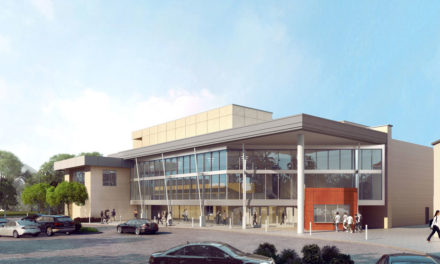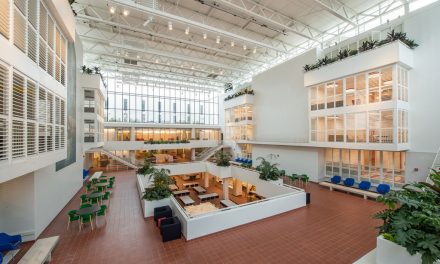The Mount Vernon Triangle Community Improvement District (MVT CID) has launched an interactive campaign to tie the neighborhood’s exciting future to its rich past. Themed “Real History, Real Life”, the series of brightly designed coasters shares 10 stories from the Triangle, with one side of each coaster portraying a historical moment from the past and the flip side of the coaster depicting the vision for today and tomorrow. It brings to life the rich history and lore of one of the most active and historically impactful communities in Washington, DC.
Real History of Mount Vernon Square
Pierre L’Enfant laid out Mount Vernon Square as one of 15 public reservations that were designed as focal points in the Federal City. The area around Mount Vernon Square was known as the Northern Liberties, a moniker given to areas that were beyond the “limits of the city.” In the first decade of the 19th Century, Congress provided funds to pave 7th Street, NW from Pennsylvania Avenue, NW to Boundary Street (now Florida Avenue) along Mount Vernon Square. As the area grew, 7th Street became an important transportation and commerce corridor, bringing new residents and businesses to the Northern Liberties neighborhood.
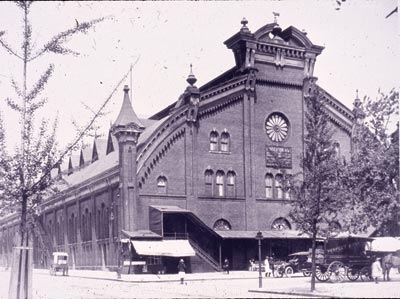
Gustav Hartig located his hardware store at 7th and K Streets in the late 19th century, where it was run by the family for 100 years. Credit: Historical Society of Washington, DC.
In 1845, the Northern Liberties Market opened on 7th Street, serving as a produce market with indoor and outdoor stalls. The market flourished and the building was expanded to accommodate growing demand. In 1872, the Northern Liberties Market moved to a bigger, more modern facility at 5th and K Streets. Other businesses such as feed stores, tailors, bars, and a dairy bottling plant clustered around the 5th & K Street location to be proximate to Northern Liberties Market customers.
However, in 1946, a devastating fire swept through the building. Although the market reopened in 1955, it never fully recovered and was closed in 1963. As residents and businesses continued to leave the neighborhood, the empty Northern Liberties Market was eventually torn down.
Real Life of Mount Vernon Square
The redevelopment of 30 acres of underutilized land in Mount Vernon Triangle began with an innovative and dynamic public-private partnership in 2002. The DC Office of Planning and ten major property owners in Mount Vernon Triangle worked to develop a comprehensive plan to revitalize the area. The DC Office of Planning and Economic Development, National Capital Revitalization Corporation, DC Department of Transportation, and the Mount Vernon Triangle Alliance were major partners. This collaborative effort produced the 2003 Mount Vernon Triangle Action Agenda, which was unveiled publicly by Mayor Anthony Williams in March 2004.
The Action Agenda includes four key action items, designed to ensure the successful development of the neighborhood:
- Developing comprehensive design recommendations for a truly livable neighborhood
- Establishing a retail plan to identify and attract a healthy mix of urban shops and services to create active and vibrant streets
- Coordinating capital improvements, including great public spaces, green space, plazas and public art
- Creating a Community Improvement District
In 2004, the Mount Vernon Triangle Community Improvement District was created to foster a clean and safe environment, promote economic development, market Mount Vernon Triangle and coordinate planning of public and private investment with the District government.
In 1875 the Northern Liberty Market was one of downtown DC’s busiest commercial centers, with 284 merchants, tradespersons and vendors. In 2008 City Vista at 5th & K opened and was a catalyst for the redevelopment of Mount Vernon Triangle. Anchored by initial tenant Busboys & Poets, City Vista is home to numerous retailers and restaurants as well as three residential towers.
In the late 19th century Gustav Hartig had located his hardware store at 7th and K Streets, where it was run by the family for 100 years. Today, the Association of American Medical Colleges (AAMC) building now fills the block, serving its nationwide academic medicine membership and bringing programs and a spirit of volunteerism to the local DC community. Five of the historic buildings from the block are adaptively incorporated into the project.
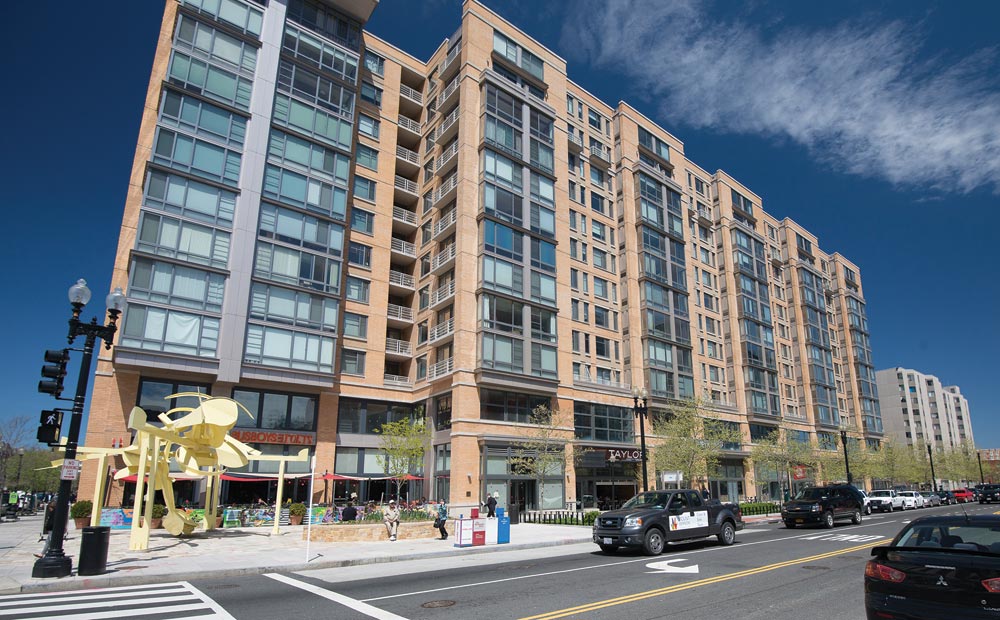
City Vista, the residential and retail community that sparked the redevelopment of MVT in the last decade, sits on the site of the Northern Liberty Market. Credit: Historical Society of Washington, DC.
Prather’s Alley once housed a blacksmith and famous milk bottling plant. The blacksmith shop building still stands today, as it is prepared to be called home to a new generation of residents, integrated into an exciting residential project.
Today, the Mount Vernon Triangle Historic District has a collection of 23 contributing buildings remaining.
Mount Vernon Triangle has become an extraordinary mixed-use neighborhood in the East End of downtown Washington, DC. There is 1.7 million square feet of office, 3,691 residential units, 238 hotel rooms, and 282,564 square feet of retail existing and under construction. The MVT neighborhood is projected to have a total build out of 2.6 million square feet of office, 4,827 residential units, 591 hotel rooms, and 356,564 square feet of retail.
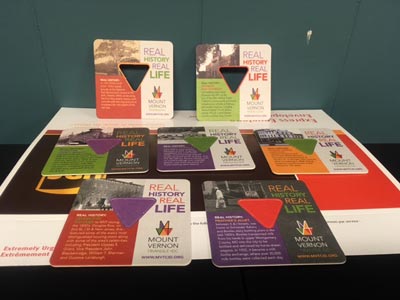
Themed “Real History, Real Life”, the Mount Vernon Triangle Community Improvement District’s series of brightly designed coasters shares 10 stories from the Triangle, with one side of each coaster portraying a historical moment from the past and the flip side of the coaster depicting the vision for today and tomorrow. Credit: Mount Vernon Triangle Community
Thousands of Real History, Real Life coasters will be distributed throughout Mount Vernon Triangle’s many restaurants and cafes through the month of June. Follow the campaign online with the #LifeinMVT hashtag. The MVT CID invites users to open it, take a photo, and share their view on social media, putting their own perspective on history in the Triangle neighborhood. Residents, office workers and visitors are invited to participate in the social media campaign, posting their pictures to Twitter or Instagram with the tagline #LifeinMVT.
MVT CID President and CEO, Kenyattah Robinson, commented on the importance of maintaining historical context even as the community experiences explosive growth in its office, residential and retail development, saying, “Mount Vernon Triangle today reflects not only one of the fastest growing downtown neighborhoods but also its years as one of the original downtown business and residential communities in Washington, DC. As a Mount Vernon Triangle resident, I am both proud and thrilled that we have found such a creative, fun and inclusive way to weave together the rich historical fabric and history of the community to the new and exciting developments to come.”
The MVT CID extends its appreciation to Anne McDonough, Library & Collections Director at the Historical Society of Washington, DC for her tireless efforts to help the MVT CID with the location and identification of key images for the coaster project and to Executive Director, John Suau, of the Society for supporting this effort. Suau noted, “The interactive feature of the MVT CID coaster project really resonates with me, both as a Mount Vernon Triangle resident and as the Historical Society launches its Street Photography Series, which encourages Washingtonians to document and seek the historical context behind neighborhoods across the city. We are pleased the MVT CID is bringing to area patrons a sense of what once was, through historical photographs from our collections.”
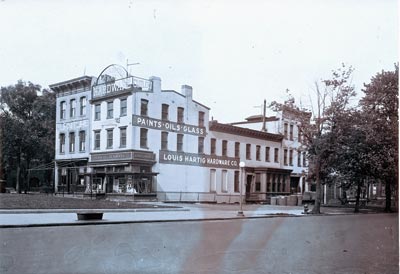
Northern Liberty Market, sometimes referred to as the Northern Liberties Market. Credit: Historical Society of Washington, DC.
Brent Leggs, a historic preservationist and Senior Field Officer for the Washington DC Field Office of the National Trust for Historic Preservation, noted, “Recognition that people living and working in a community value the context, history and story behind a place is part of a broader narrative and a priority for the National Trust. We are pleased to be working with the MVT CID in celebrating the diversity, authenticity and cultural richness of the Mount Vernon Triangle community and preserving the stories, culture and life histories of the neighborhood.”
Local design firm, Williams Whittle, was retained to design the coasters and the campaign through an RFP process in late 2015. Months of research and interviews elicited many historic facts – and fascinating tales – from a downtown Washington, DC community that has grown and thrived for hundreds of years, and that continues to evolve today.
About The Mount Vernon Triangle Community Improvement District
The Mount Vernon Triangle Community Improvement District is a private, nonprofit organization established to enhance the overall quality of life for all members of the community including residents, visitors, business owners, and property owners in the Mount Vernon Triangle neighborhood in Downtown DC. The Mount Vernon Triangle is considered to be one of Washington DC’s best examples of a mixed-use community, a vibrant neighborhood in the heart of the City—both geographically and culturally. Its boundaries include 17 blocks within the East End of downtown Washington, D.C., bordered by Seventh Street to the west, Massachusetts Avenue to the south, New York Avenue to the north and New Jersey Avenue to the east. The Mount Vernon Triangle is a welcoming, authentic, and centered neighborhood that mirrors the City’s unique mix of historic and modern buildings, longtime and new residents, and diverse cultures, restaurants, and urban experiences. For more information, we invite you to explore our website at www.mvtcid.org or follow us on Facebook at www.facebook.com/MountVernonTriangleCID, Twitter @MVTCID, Instagram https://www.instagram.com/mvtcid/ and Flickr https://www.flickr.com/photos/111344023@N05/.
Source: The Mount Vernon Triangle Community Improvement District www.mvtcid.org

